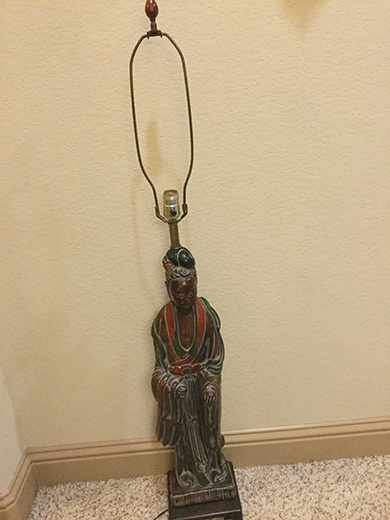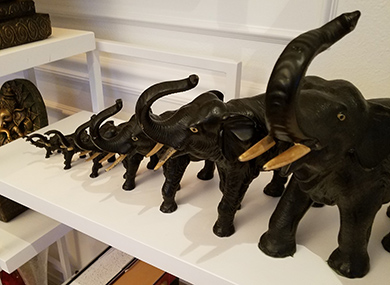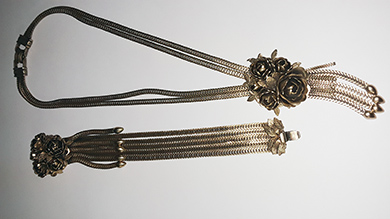 |
|
|||
 |
 |
|||
RINKER ON COLLECTIBLES — Column #1703 Copyright © Harry Rinker, LLC 2019 Questions
and Answers
QUESTION: I met your wife Linda and you during on our 2017 Alaskan Cruise/motor coach/rail trip. During the train ride from Denali to Anchorage, we talked about your book “Sell, Keep, or Toss” and my eventually having to deal with my mother’s things when she died. My mother passed away a few month ago. I would like your opinion about the value and disposal options for a Fredrick Cooper lamp with a carved Asian figure lamp standard that belonged to her. – TB, McKinney, TX, Email Question 
ANSWER: Frederick Cooper, a Chicago artist, established his studio in 1923. He began his career as a sculptor and watercolorist. In the 1920s, Chicago was experiencing an architectural renaissance. Cooper became fascinated with lamps, especially those that combined a range of materials such as brass, glass, fabric, and wood. The Frederick Cooper Lamp Company, located in Rocky Mount, North Carolina, is still in business. The company has a showroom in High Point, North Carolina, now the American furniture capital. Today’s lamps contain a combination of alabaster, art glazed ceramic, brass, bronze, copper, crystal, jade, marble, nickel, painted porcelain, and wood. The website www.chelseahouseinc.com notes in its section about Frederick Cooper that: “We carefully select a luxurious fabric to shade each lamp base. Our signature Frederick Cooper shades are peerless in execution… The picture of the lamp that accompanied your email shows it without its shade. If you do not have the period shade, approximately half the resale value of the lamp is gone. Have you priced the cost of middle to high-end shades? When a potential buyer looks at your lamp, he/she is going to subtract the cost of the shade from the price he/she is willing to pay. You need to do web research to answer two questions. Is your mother’s lamp still in production? While I suspect it is not, double check. Study the prices of new Frederick Cooper lamps. Cut the value in half to determine the price of the standard without the shade. Once you have an average cost, reduce it by 50 percent. This is the most you will be able to realize from the sale of your lamp. In reality, you will get even less. A WorthPoint.com “Frederick Cooper lamp” search resulted in my finding an exact match for your lamp. It sold for $100.00 on December 6, 2016 as reported by eBay. Since this lamp had its shade, a realistic sell through price for your lamp without its shade is between $40.00 and $50.00. In order to sell your lamp quickly, you will need to undercut current asking prices. Hence, your lamp’s secondary market quick resale value is between $25.00 and $30.00. The good news is that McKinney is in the Dallas-Fort Worth metropolitan area. Asian theme pieces are favorites of interior decorators seeking accent pieces. The negatives are: (1) your lamp has no collector value (no collector is seeking to own 100 examples of Frederick Cooper lamps); (2) it is a standalone lamp (pairs sell better); and (3) the period shade is missing. Craigslist offers the best sales option. List it at “best offer above $35” and keep your fingers crossed. QUESTION: Could you tell me what my political pin might be worth? It is a brass button with Franklin D. Roosevelt and John N. Garner on it. It says “Medallic Art Co. / New York City / New York.” It says “A New Day, A New Deal.” -- LR, Hickory, PA, Mail Question ANSWER: Because your description was somewhat confusing, it took me longer than I expected before I found the answer. This is why I encourage readers to send or email photographic images along with their questions and/or provide detailed descriptions that explain what is on the front and then the back or describe an object from top to bottom or side to side. You have a political button or more correctly a political pinback. The pinback you own was used during the 1932 Presidential campaign pitting Franklin D. Roosevelt, the Democratic candidate, against Herbert Hoover, the Republication candidate. Your pinback button is made of brass. It is known as a jugate because it pictures both the presidential and vice-presidential candidates. It is 1 15/16 inches in diameter. The pin features a relief image of the two faces. Garner’s partial left facial profile is behind Roosevelt’s full left face profile. The banner beneath the faces reads: “FRANKLIN D. ROOSEVELT / JOHN N. GARNER. “A NEW DAY” is along the left border and “A NEW DEAL” on the top. The Medallic Art Company of New York did make the pin. Its MACO stamp is on the reverse side. The two primary campaign slogans during the 1932 campaign were “Happy Days Are Here Again” for the Democrats and “We Are Turning The Corner” for the Republicans. An attempt to find other 1932 Democratic campaign material with the slogan of “A New Day, A New Deal” was unsuccessful. A check of WorthPoint.com produced several 2018 sell through listings for your political pinback. The high price was $24.95. The lowest was $10.00. A reasonable secondary market value for an example in very good or better condition is between $17.00 and $19.00. An example did sell through in 2006 for $41.02. 2006 is a long way away from 2019. The Great Recession and the passing of time impacted many segments of the antiques and collectibles market. Political pinbacks were not immune. Given your Roosevelt/Garner pinback’s value, it will be a difficult sell. My advice is to take any offer above $10.00. The best method is to take it to a local flea market, find a seller who specializes in political material, and offer it to him/her. QUESTION: I own a graduated set of seven wooden elephants. My thinking is that they date back to shortly after World War II. Do they have any value? – DD, Houstin, TX, Email Question 
ANSWER: My first response to anyone who brings me one or more carved elephant figurines is: “These will be a tough sell to Democrats.” The value of old age is that one comes into contact with a great many objects during the aging process. An antiques and collectibles appraiser’s and/or writer’s expertise is enhanced by him/her having paid attention and remembering what was seen. Having grown up in the period immediately following World War II, carved elephant figurines resided on mantels and shelves, china cabinets, and whatnot shelves in homes across America. Many were brought home by G.I.s who served in the Far East. The carved elephant fixation persisted as travel to the Far East increased in the 1950s and 1960s. Travelers bought these cheap souvenirs as presents for family and friends. By the 1970s, most carved elephants were relegated either to the back of shelves and china cabinets, stored away in a shoebox that found its way to a closet or basement, or discarded. A check of the differences between an African and Asian elephant revealed that your elephants are Asian in origin. Asian elephants have a twin-domed head with an indent in the middle and ears that resemble the continent of India. As might be expected, the quality level of elephant figurines varies considerably. Judging from the photograph that accompanied your email, the quality of your set is middling – not terrible but not great. Modern day demand for sets of carved elephants is minimal. A fair secondary market value for the set is around $50.00. Getting someone to pay this is an entirely different matter. QUESTION: During a recent visit to Florida, I paid $10.00 for a brass necklace and bracelet set. When doing an internet search for “brass jewelry,” it referred me to Victorian brass jewelry. I found an eBay listing for a Victorian mesh slide bracelet that has tassels similar to my piece. What exactly do I have? – LS, Email Question 
ANSWER: You do not have a piece of Victorian era jewelry. Metal tassels have been used as a jewelry decorative element for centuries. An analysis of the image that accompanied your email suggests you have a piece of costume jewelry made between the late 1950s and the 1970s. The $10.00 you paid is a fair price for the set. Harry L. Rinker welcomes questions from readers about
collectibles, those mass-produced items from the twentieth and twenty-first centuries.
Selected letters will be answered in this column.
Harry cannot provide personal answers.
Photos and other material submitted cannot be
returned.
Send your questions to: Rinker on Collectibles, 5955 Mill
Point Court SE, Kentwood, MI 49512.
You also can e-mail your questions to
harrylrinker@aol.com.
Only e-mails containing a full name and mailing address
will be considered.
|
||||